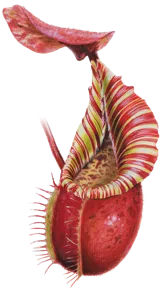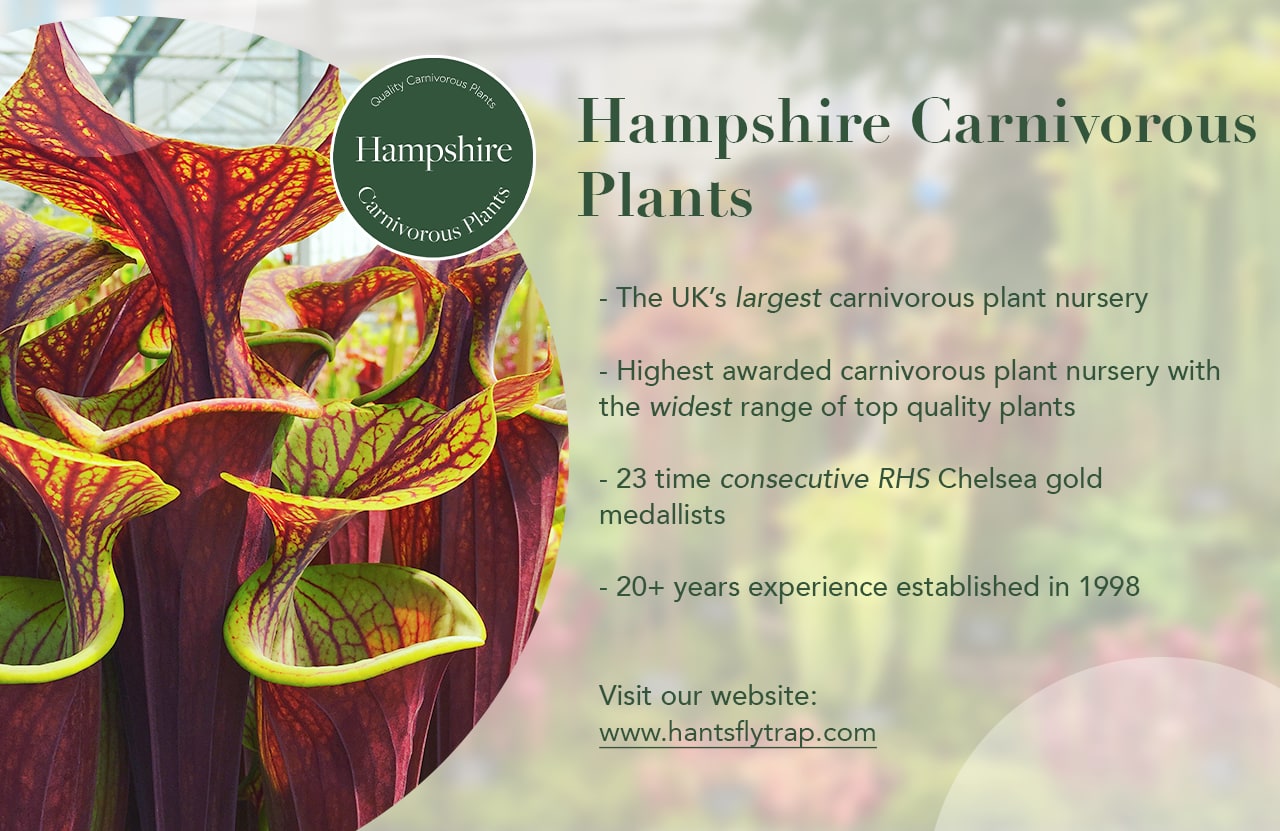As an Amazon Associate, I earn commission from qualifying purchases.
North American pitcher plants have it all: fearsomely efficient flycatchers and easy for beginners to grow, the eight species of Sarracenia are bizarre and beautiful.
Most have tall, narrow pitchers which attract insects with bright colours and inviting scents. Visitors are forced into perilous positions by waxy surfaces or tricked by transparent leaves, while nectar laced with poison intoxicates them. Those who slip and tumble down the pitcher are trapped by downward-pointing hairs and quickly digested by the plant’s own enzymes.
Many Sarracenia - also known as trumpet pitchers - are very easy growers, and are among the best carnivorous plants for beginners. But with 8 different species, countless forms of each, and the infinite possibilities of hybridisation, collecting Sarracenia can become a lifelong hobby!
Let’s get started!
- Where do pitcher plants come from?
- List of Sarracenia species
- Growing Locations
- Soil & Water
- Winter Dormancy & Division
- Feeding Pitcher Plants
- Where to buy Pitcher Plants
1. Where do pitcher plants come from?
Sarracenia pitcher plants are mostly found on the southeastern coastal plains of North America, and grow in sunny, open wetlands. The greatest diversity can be found in Alabama, Georgia, and South Carolina, although one species extends north along the east coast into the Upper Midwest and Canada. Sarracenia populations have declined rapidly in recent years due to drainage of their habitats for housing developments. Some species are now critically endangered.
Hover for more detail, and use the controls on the left to zoom.
Notes: Map data sourced from McPherson & Schnell's 2011 monograph Sarraceniaceae of North America, the USDA PLANTS Database, and Barry Rice's website. Non-native species (e.g. any planted in California) have been omitted. If you spot any mistakes, please click here to send me an email.
2. List of Sarracenia Species
There are currently eight recognised species of Sarracenia (taxonomic controversy aside!). These are:
- Sarracenia alata - “the Pale pitcher plant”
- Sarracenia flava - “the Yellow pitcher plant”
- Sarracenia leucophylla - “the White pitcher plant”
- Sarracenia minor - “the Hooded pitcher plant”
- Sarracenia oreophila - “the Green pitcher plant”
- Sarracenia psittacina - “the Parrot pitcher plant”
- Sarracenia purpurea - “the Purple pitcher plant”
- Sarracenia rubra - “the Sweet pitcher plant”
Each species varies considerably and some are further divided into subspecies, but for a general primer, check out the gallery below.

North American pitcher plants are unusual in that all species can be hybridised, and that these crosses result in fertile offspring. In other words, Sarracenia taxonomy involves a fascinating mixture of complex hybrids, backcrosses and cultivars, many of which are extraordinarily beautiful!
Many hybrids occur naturally in the wild and were once given names as if they were species. Sarracenia × catesbaei, for example, is a hybrid between Sarracenia flava and Sarracenia purpurea, while Sarracenia × moorei is Sarracenia flava crossed with Sarracenia leucophylla.
The vigour often exhibited by hybrids is another reason why hybrids - along with the super-hardy Sarracenia purpurea! - are frequently recommended to first-time growers. In the UK, Hampshire Carnivorous Plants sells a wide variety of pitcher plants including famous cultivars like S. ‘Brooks Hybrid’ and S. ‘Judith Hindle’ as well as fun crosses suitable for beginners. US nursery California Carnivores has an extensive Sarracenia breeding program, and they offer a wide range of attractive and easy-growing pitcher plants. By using the code tomscarnivores at checkout, you’ll also get 10% off your order!
3. Where to grow pitcher plants
Sarracenia grow best in full direct sun. As such, they are candidates for only the brightest of windowsills - a lack of direct sunlight will cause your plants to become weak and poorly-coloured. If you wish to grow Sarracenia on a windowsill, choose a smaller species like Sarracenia purpurea or a hybrid involving it.
Terrariums are generally unsuitable. While seedlings can thrive in a terrarium, you will struggle to provide the light intensity required by adult plants. Remember too that erect species like Sarracenia leucophylla can reach almost a meter tall!
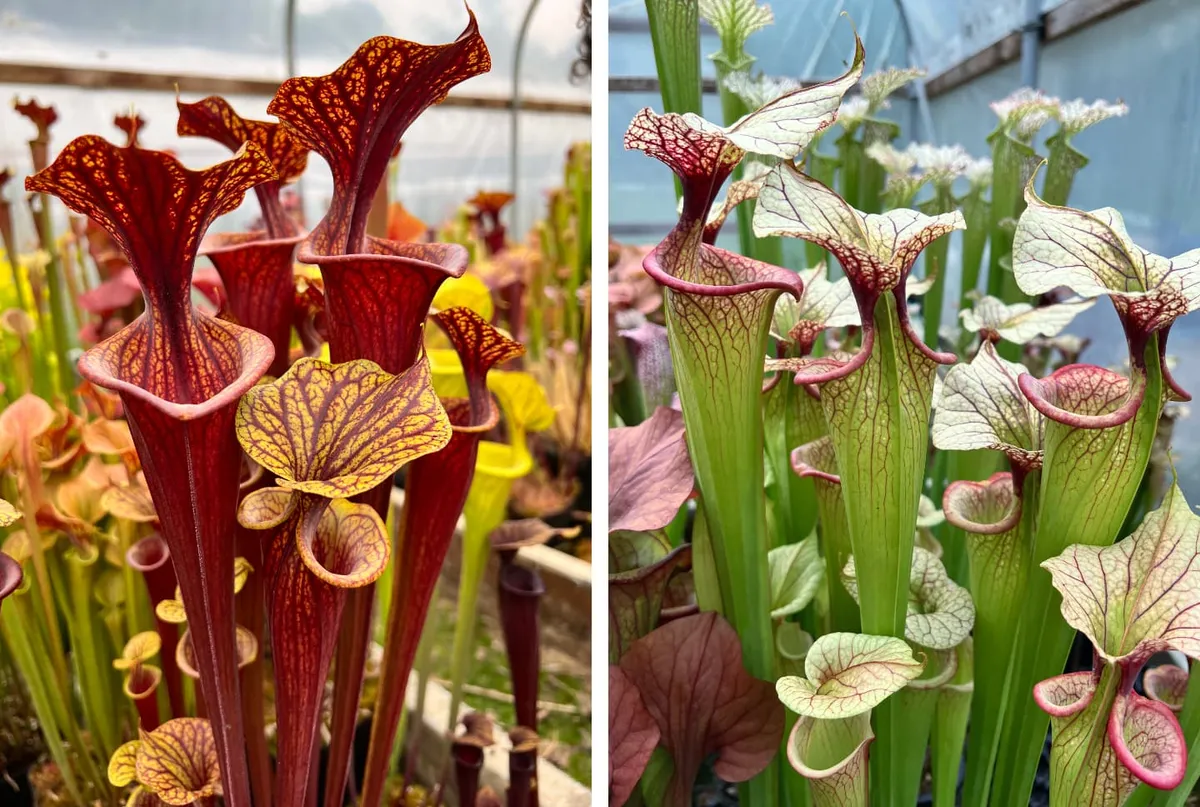
Generally, Sarracenia grow best in unheated greenhouses and conservatories. They are quite temperature tolerant, with conditions in their natural habitats frequently reaching 32°C (90°F) during summer. While some can be grown outside year-round in the US and UK - in a bog garden, for example - the taller species don’t always cope well with strong winds, and as such are better suited to growing behind glass.
4. Soil & water for pitcher plants
Like many other carnivorous plants, Sarracenia require rainwater, distilled water, or deionised water, and lots of it! This is because they grow in low-nutrient waterlogged soil, and evolved to draw minerals from prey instead. As such, you must avoid tap water, bottled water and filtered water - all will result in a build-up of minerals and cause your plant’s health to deteriorate. You should not use fertiliser for similar reasons. I’ve outlined your options for obtaining water in more detail here.
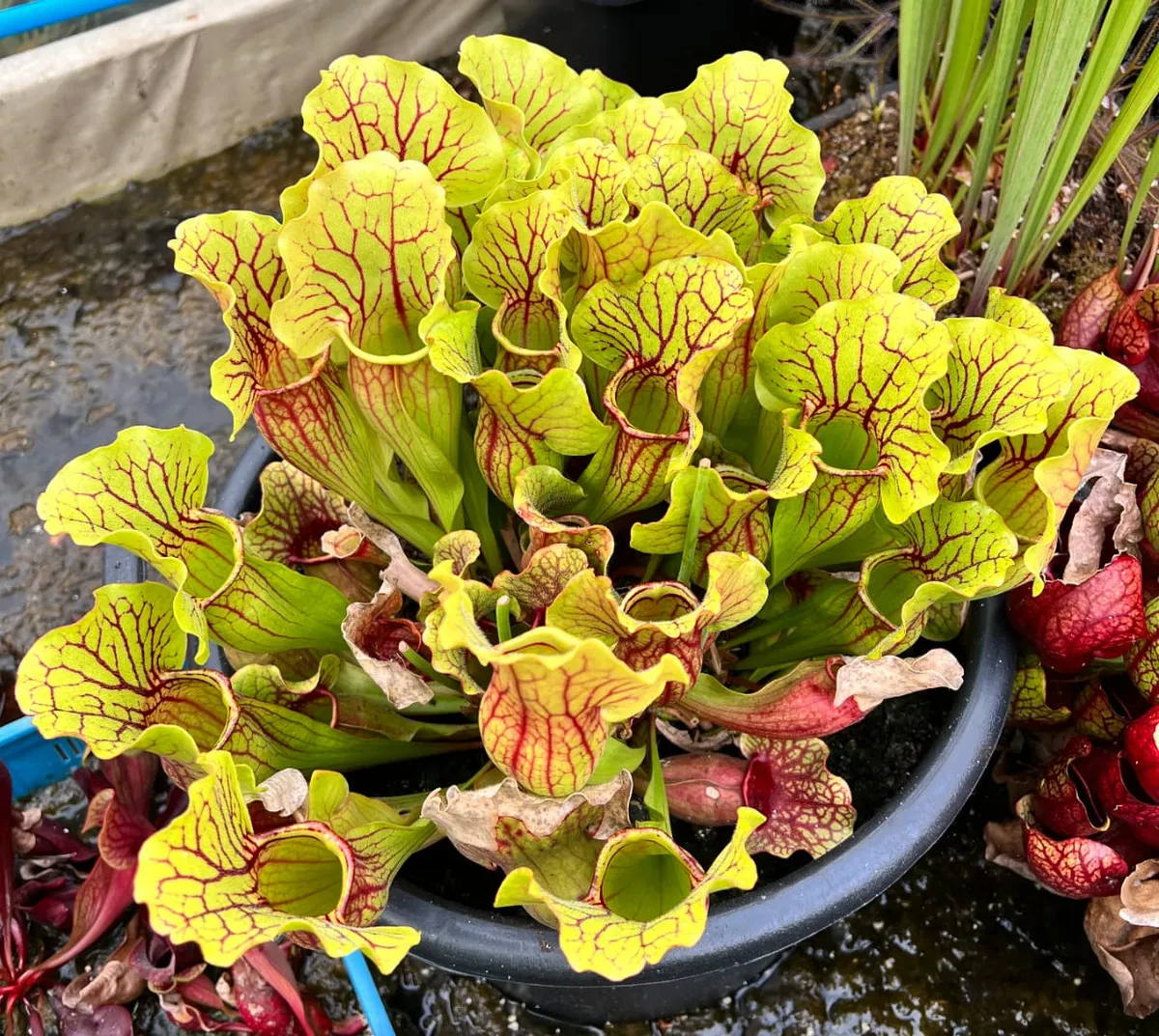
During the growing season, you should stand your plants’ pots in about 2cm of water (just under an inch) and avoid watering from the top. During winter, the soil should be kept just damp, rather than wet.
The traditional compost mixture for Sarracenia is sphagnum peat moss mixed with either lime-free horticultural sand or perlite, to a ratio of about 2:1. UK readers can buy bags of ready-made Sarracenia compost from Hampshire Carnivorous Plants. In the US, California Carnivores offers an excellent ready-made soil mix. Alternatively, you can buy this compost mix on Amazon worldwide.
5. Winter dormancy & division
All North American pitcher plants require a cold winter dormancy between November and February. Temperatures in their natural habitats regularly dip below freezing over winter (0°C / 32°F), and so you must provide a cold season for plants in cultivation.
If you keep your plants indoors during the growing season, you will need to move them somewhere colder - sit them next to a window in your shed or garage, for example. Plants growing in an unheated greenhouse can remain there over winter. For year-round outdoor growing (i.e. exposure to the elements), species occurring further north - Sarracenia purpurea, Sarracenia flava and their hybrids - are generally the hardiest in UK weather.
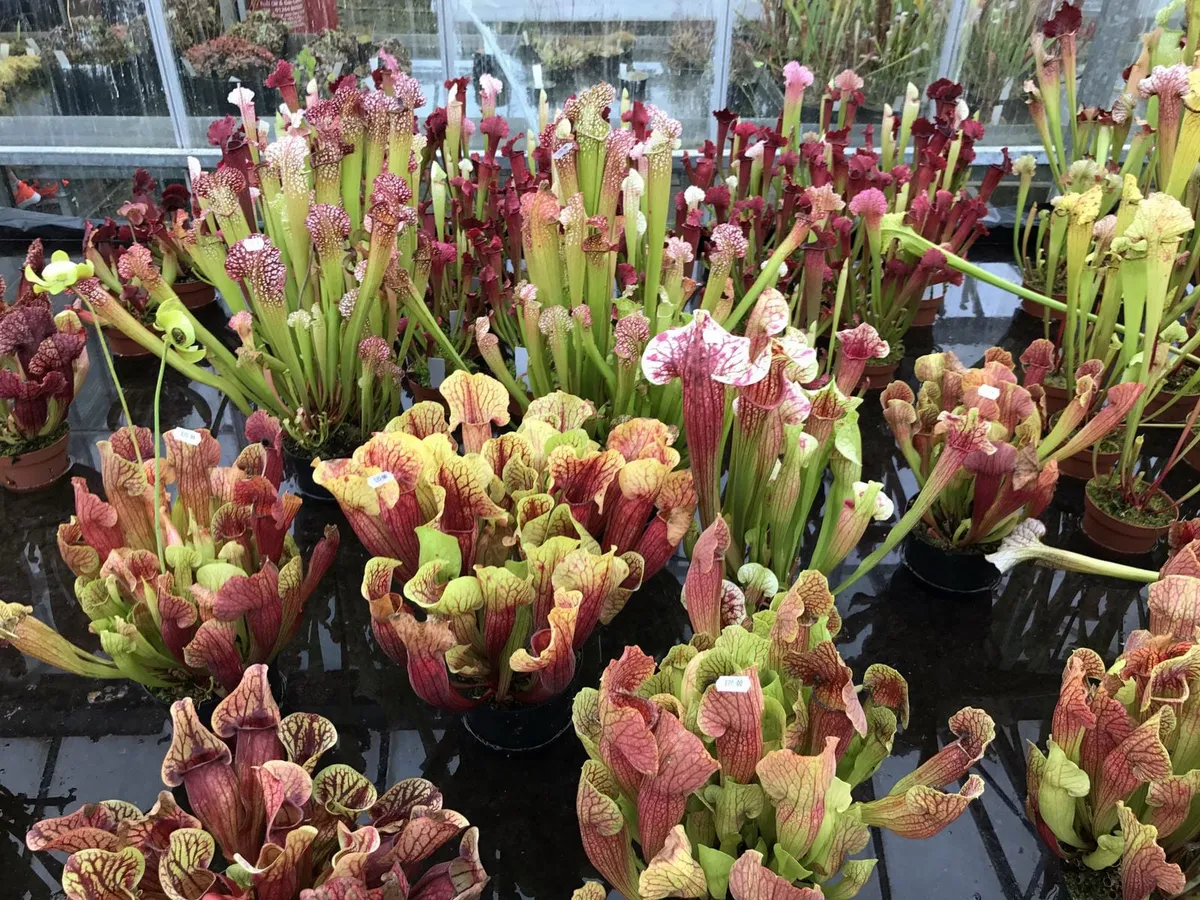
As the days shorten and the temperature drops, pitchers will turn brown and your plant will start to die back. This is normal, and you can safely trim off any dead growth. Some Sarracenia will also produce flat, non-carnivorous leaves called phyllodia during autumn; these will often last throughout winter.
The end of the winter dormancy period is a good opportunity to repot and divide your plants, if they require it. Sarracenia grow from a rhizome, which is a thick underground stem that sprouts roots and leaves. Large adult plants will often have multiple growth points on their rhizome, and by snapping the rhizome and potting the pieces separately, you can propagate multiple (genetically identical) plants! Check out this guide by Phil Wilson for some helpful photos and a detailed tutorial.
6. What to feed Pitcher Plants
Kept outside, Sarracenia will catch more than enough food for themselves. The taller trumpet species such as Sarracenia flava and Sarracenia leucophylla are particularly ruthless, and often fill to the brim with flies, wasps, ants, and moths by the end of the growing season.
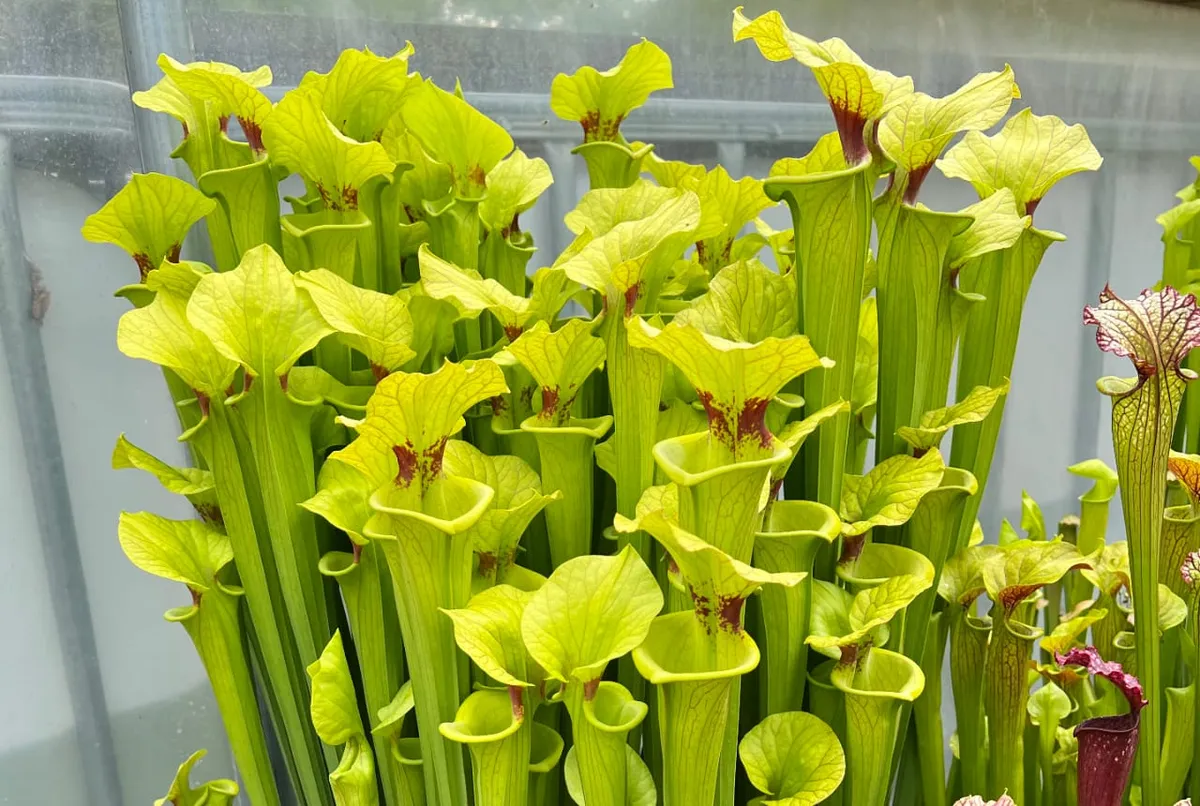
If you keep your plants indoors, you can hand feed them with dried insects every few weeks. The foods I’ve recommended for Venus flytraps are all suitable, but dried crickets are particularly good.
7. Where to buy Pitcher Plants
You can buy Trumpet pitcher plants from Hampshire Carnivorous Plants in the UK. They also sell compost, seeds, and plant collections including great companion plants like Sundews and Venus flytraps. Delivery is available throughout the UK.
If you’re in the US, I wholeheartedly recommend California Carnivores. They have a wide range of pitcher plants available for delivery throughout the United States, as well as ideal companions like Venus Flytraps and Sundews.
You can also get 10% off your order with the code tomscarnivores.
Plants bought from specialist carnivorous plant nurseries will typically be much stronger and more robust than those from hardware / DIY stores. You’ll also get much better advice on successful growing, and you’ll be supporting a small business!
Still want to learn more?
Buy The Savage Garden, by Peter D’Amato. In my opinion, this is the single best book on carnivorous plants you can buy today. Its chapters on Sarracenia are brilliantly detailed and great for beginners. Available on Amazon.
